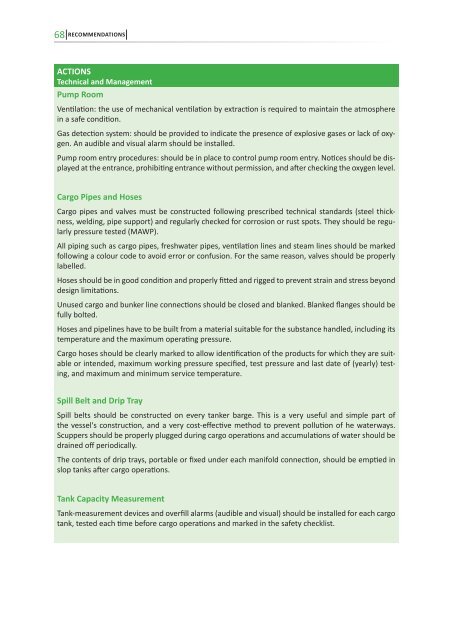Carriage, Handling and Storage of Dangerous Goods along
Carriage, Handling and Storage of Dangerous Goods along
Carriage, Handling and Storage of Dangerous Goods along
You also want an ePaper? Increase the reach of your titles
YUMPU automatically turns print PDFs into web optimized ePapers that Google loves.
68 RECOMMENDATIONS<br />
ACTIONS<br />
Technical <strong>and</strong> Management<br />
Pump Room<br />
Ventilation: the use <strong>of</strong> mechanical ventilation by extraction is required to maintain the atmosphere<br />
in a safe condition.<br />
Gas detection system: should be provided to indicate the presence <strong>of</strong> explosive gases or lack <strong>of</strong> oxygen.<br />
An audible <strong>and</strong> visual alarm should be installed.<br />
Pump room entry procedures: should be in place to control pump room entry. Notices should be displayed<br />
at the entrance, prohibiting entrance without permission, <strong>and</strong> after checking the oxygen level.<br />
Cargo Pipes <strong>and</strong> Hoses<br />
Cargo pipes <strong>and</strong> valves must be constructed following prescribed technical st<strong>and</strong>ards (steel thickness,<br />
welding, pipe support) <strong>and</strong> regularly checked for corrosion or rust spots. They should be regularly<br />
pressure tested (MAWP).<br />
All piping such as cargo pipes, freshwater pipes, ventilation lines <strong>and</strong> steam lines should be marked<br />
following a colour code to avoid error or confusion. For the same reason, valves should be properly<br />
labelled.<br />
Hoses should be in good condition <strong>and</strong> properly fitted <strong>and</strong> rigged to prevent strain <strong>and</strong> stress beyond<br />
design limitations.<br />
Unused cargo <strong>and</strong> bunker line connections should be closed <strong>and</strong> blanked. Blanked flanges should be<br />
fully bolted.<br />
Hoses <strong>and</strong> pipelines have to be built from a material suitable for the substance h<strong>and</strong>led, including its<br />
temperature <strong>and</strong> the maximum operating pressure.<br />
Cargo hoses should be clearly marked to allow identification <strong>of</strong> the products for which they are suitable<br />
or intended, maximum working pressure specified, test pressure <strong>and</strong> last date <strong>of</strong> (yearly) testing,<br />
<strong>and</strong> maximum <strong>and</strong> minimum service temperature.<br />
Spill Belt <strong>and</strong> Drip Tray<br />
Spill belts should be constructed on every tanker barge. This is a very useful <strong>and</strong> simple part <strong>of</strong><br />
the vessel's construction, <strong>and</strong> a very cost-effective method to prevent pollution <strong>of</strong> he waterways.<br />
Scuppers should be properly plugged during cargo operations <strong>and</strong> accumulations <strong>of</strong> water should be<br />
drained <strong>of</strong>f periodically.<br />
The contents <strong>of</strong> drip trays, portable or fixed under each manifold connection, should be emptied in<br />
slop tanks after cargo operations.<br />
Tank Capacity Measurement<br />
Tank-measurement devices <strong>and</strong> overfill alarms (audible <strong>and</strong> visual) should be installed for each cargo<br />
tank, tested each time before cargo operations <strong>and</strong> marked in the safety checklist.













